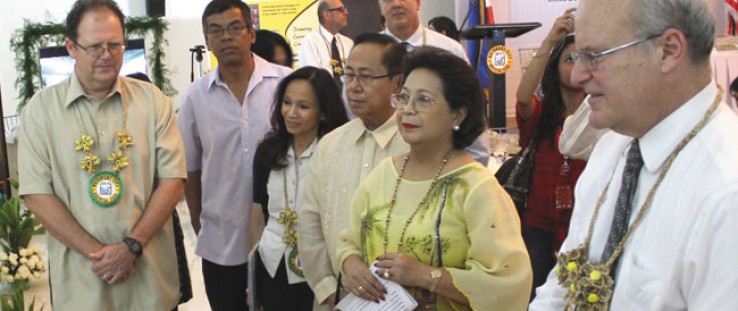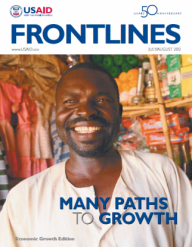 USAID Deputy Administrator Donald Steinberg, right, views an exhibit highlighting the environmental partnership between USAID and Batangas City, Philippines. USAID has helped the city develop its greenhouse gas inventory and provide electricity for school
USAID Deputy Administrator Donald Steinberg, right, views an exhibit highlighting the environmental partnership between USAID and Batangas City, Philippines. USAID has helped the city develop its greenhouse gas inventory and provide electricity for school
 USAID Deputy Administrator Donald Steinberg, right, views an exhibit highlighting the environmental partnership between USAID and Batangas City, Philippines. USAID has helped the city develop its greenhouse gas inventory and provide electricity for school
USAID Deputy Administrator Donald Steinberg, right, views an exhibit highlighting the environmental partnership between USAID and Batangas City, Philippines. USAID has helped the city develop its greenhouse gas inventory and provide electricity for school
USAID Deputy Administrator Donald Steinberg, right, views an exhibit highlighting the environmental partnership between USAID and Batangas City, Philippines. USAID has helped the city develop its greenhouse gas inventory and provide electricity for schools using renewable energy technology.
Nearly a quarter of Filipino households still lack access to electricity—3 million out of 14 million homes. Poverty, the high cost of energy, lack of investment in the power industry, and slow implementation of the government’s energy policies contribute to so many Filipino homes remaining stifled in darkness.
The country will need to increase access to power nationally and to electricity services locally for its economy to reach its potential rate of growth. The Philippine Government is working on both fronts to achieve its target of expanding basic electricity services to 90 percent of households by 2017.
But it is also courting a particular kind of growth—a green economy that increases energy production while decreasing the rate of greenhouse gas (GHG) emissions.
While its economic growth forecast presents an improving trend, from 3.7 percent in 2011 to 6.4 percent in the first quarter of 2012, the Philippines continues to be threatened by the adverse impacts of climate change. According to a U.N. study, the country incurs economic losses of about $230 million annually due to severe typhoons, floods and extreme droughts.
Although the Philippines is not a major greenhouse gas emitter, it recognizes the need to take a more active role in mitigating the effects of climate change by shifting to clean and renewable energy sources. The Philippine National Framework Strategy on Climate Change demonstrates the country’s commitment to this low-emission pathway to growth.
The U.S. Government is helping approximately 20 countries implement low-emission development strategies (known as LEDS) by 2014. In the Philippines, U.S. experts are increasing the country’s ability to better track greenhouse gas emissions—an integral step in monitoring, reporting, and, eventually, limiting the main drivers of climate change. LEDS entails rigorous analysis and long-term planning to support development objectives and unique circumstances.
A Model City
Oliver Gonzales, environment and natural resources officer of Batangas City, is leading the efforts to complete a GHG inventory report to use as a foundation to design a local climate change action plan.
“GHG inventory is a way of measuring the livability of a community. If we know our emissions, we know our source. We know what to do, when and how to act, and then we live healthy,” Gonzales said.
Batangas City, a USAID partner for LEDS, and a top revenue-earning city, is also considered one of the Philippines’ economic growth centers.
Since 2010, USAID has provided training countrywide on global climate change, greenhouse gas accounting and management to more than 1,000 individuals like Gonzales from the government, academic institutions and private organizations through online courses and face-to-face workshops.
At the national level, in February and April, USAID held planning and technical meetings on greenhouse gas inventory for the agriculture, forestry, land use and energy sectors.
USAID/Philippines Mission Director Gloria Steele said: “Tracking GHG emissions enables governments and industry to identify the most cost-effective options for reducing emissions while growing their economies. By monitoring emissions and other key data in a transparent and rigorous way, the public, government and industry can properly gauge if changes are leading to the desired environmental and economic impact.”
Transparent, high-quality data are also essential for the Philippines to access international climate funds for its energy reforms, and attract private investment for energy projects.
“The transparent and participatory nature of LEDS strengthens governance, facilitates investment, and highlights opportunities for growth, while reducing opportunities for graft,” said Steele.
It Pays to Conserve
To complement its technical expertise in devising the LEDS strategy, USAID has been supporting programs in the Philippines on energy conservation and efficiency and the use of clean energy. Since 2002, the Agency, through its Alliance for Mindanao Off-Grid Renewable Energy (AMORE) project, has provided electricity to more than 13,000 households in 474 remote rural villages. Using solar photovoltaic cell and micro-hydro power systems—harnessing the power of the sun and water—USAID/AMORE has installed more than 300 renewable energy-powered street lights and illuminated more than 140 community centers.
The project has also provided 224 schools with equipment that converts solar power to electricity, enabling students to access distance education services and audio-visual materials.
Batangas City is also moving towards developing a comprehensive GHG management plan to complement its advocacy for green infrastructure and eco-industrial park development.
“We are not just talking about a city that is an award-winning livable community or one that has environmental protection. We’re not simply talking about the city that has won awards for its good governance. We are talking about a city that draws together the best of its entire population,” said USAID Deputy Administrator Donald Steinberg on a recent trip to Batangas City.
Paving the Way for LEDS in the Philippines
In the Philippines, LEDS is likely to lead to public and private investments in power generation, energy efficiency, transport planning, clean energy, and sustainable forest and mangrove management.
“Improving management of forests and mangroves is a strategic investment because they not only absorb and store carbon, but also serve as a buffer to storms and flooding, helping the Philippines protect itself from the negative effects of climate change,” says Steele.
Protecting and sustaining the country’s natural resources is a key component of the U.S. and Philippine Governments’ joint pursuit of broad-based and inclusive growth under the Obamaadministration’s Partnership for Growth (PFG) initiative as well (see sidebar). The PFG will mobilize the resources of both governments to address the most serious constraints to economic growth and development in the Philippines.
Gonzales attributes the success of Batangas City’s green programs not only to the leadership of the city government but, more importantly, to the commitment of private partners and the community to sustainable development.
“As we continue to pursue initiatives for sustainable and inclusive development, we will continue to rely on our progressive relationship with the community. We also hope to serve as a role model for communities throughout the Philippines so that we can make a huge contribution in the global campaign against climate change,” Gonzales said.
This article was written by staff from USAID’s mission in the Philippines.
A Partnership for Green Growth
What prevents a country from reaching higher growth rates? The Philippines, along with Ghana and Tanzania, are part of the first group of pioneer countries the United States is working with to solve this economic riddle.
Launched in Manila in 2011 by Secretary of State Hillary Rodham Clinton, the Obama administration's Partnership for Growth (PFG) seeks to identify the various bottlenecks that keep the Philippines from achieving its maximum economic potential. Over a five-year period, analysts from both countries identified two primary constraints to growth: weak governance and poor investment climate.
LEDS interventions, such as improving transportation through alternative technologies, reducing the high cost of electricity, and promoting access to affordable power, will directly address those constraints.
“The Partnership for Growth is fostering inclusive economic growth in the next generation of emerging markets, while LEDS is key to achieving the country’s economic goals by focusing on sustainable natural resources management,”says USAID/Philippines Mission Director Gloria Steele. “Together, both efforts will work together to achieve sustainable and inclusive economic growth in the Philippines.”









Comment
Make a general inquiry or suggest an improvement.